| Dodge Power Wagon | |
|---|---|
.jpg.webp) 1954 Power Wagon | |
| Overview | |
| Manufacturer | Dodge (Chrysler) |
| Production | 1945–1980, 2005–present |
| Model years | 1946–1980, 2005–present |
| Assembly | Warren, Michigan, United States |
| Body and chassis | |
| Class | Full-size pickup truck |
| Layout | Front engine, four-wheel drive |
| Related | Ocdresto Classic truck resto Legacy Dodge Carryall |
| Powertrain | |
| Engine | 360 cu in (5.9 L) LA V8 |
| Dimensions | |
| Wheelbase | 126 in (3,200 mm) |
| Chronology | |
| Predecessor | Dodge WC series |
| Successor | Dodge Ram |
The Dodge Power Wagon is a four-wheel drive medium duty truck that was produced in various model series from 1945 to 1980 by Dodge.[1] The Power Wagon name was revived for the 2005 model year as a four-wheel drive version of the Dodge Ram 2500.[2][3] As a nameplate, "Power Wagon" continues as a special package of the four-wheel drive version of 3/4 ton Ram Trucks 2500 model.[4]
The original civilian version, commonly called the "flat fender" Power Wagon (FFPW) or "Military Type", was mechanically based on Dodge's 3/4-ton WC series of World War II military trucks.[5] The Power Wagon was the first 4x4 medium duty truck produced by a major manufacturer in a civilian version. It represents a significant predecessor to the many modern four-wheel drive trucks in use today.[6] It was marketed as the WDX truck.[7] Until about 1960 it was internally known by its engineering code T137 – a name still used for the original series by enthusiasts.[8] Following Chrysler Corporation policy of badge engineering to provide a greater number of sales outlets overseas, Power Wagons were also marketed around the world under the Fargo and De Soto badges.[6][9]
Starting in the 1957 model year, factory four-wheel-drive versions of the Dodge C Series trucks were produced and sold as the W-100, W-200, W-300, and W-500, alongside the older Power Wagon. The pickups had the "Power Wagon" badge on the fender.[10] The older design Power Wagon was marketed as the "Military Type" to distinguish it from the styled pickup versions. Later the "Military Type" was given the series number W-300M, and ultimately WM-300.
The heavy-duty four-wheel-drive W-300 and W-500 trucks were marketed as "Power Giants".[10][11] The four-wheel-drive version of the Dodge Town Wagon also got the "Power Wagon" badge.[10] The "Military Type" sales in the United States ended by 1968, because the vehicle did not comply with new federal light-duty truck regulations.[1] The "Power Wagon" options continued on the Dodge D-Series through the 1980 model year. For the 1981 model year, "Power Ram" became the marketing logo for the medium-duty Dodge trucks, and the "Power Wagon" name was not used until the 2004 revival.[10]
Civilian 1-ton Power Wagon "Military-Type", Flat Fender Style" (1945-1978)

The Military style Power Wagon had three series during its lifetime, with different model numbers. The nominal one-ton rated Power Wagon's gross vehicle weight rating (GVWR) was 8,700 pounds. Its maximum payload was 3,000 pounds. It was produced starting in the 1946 model year, and U.S. sales ended in 1968. Export sales continued through 1978.
The civilian Power Wagon continued the lineage of limited production Dodge 4WD trucks from the 1930s, that proved basic four-wheel drive design concepts, primarily for the military. Mechanically derived from Dodge's 1942–1945 3/4-ton WC series military trucks, the Power Wagon was introduced in 1946 as the first civilian production 4x4 truck. During its development phase, it was initially named the WDX General Purpose Truck, a name still used on some of the preliminary materials handed out by Dodge, before sales began in March 1946. The 'W' was a continuation of the 1941–1947 model year series, followed by a 'D' instead of a 'C', because the civilian truck was a 1-ton rating instead of the Army's 3⁄4-ton, and the 'X' was added to indicate four-wheel drive, as opposed to all previous civilian two-wheel driven models.[12] Some believe the truck was renamed "Power Wagon" after a contemporaneous trucking magazine with that title.[13][14]
Meant to compete with military-based Ford/Marmon-Herrington and GMC trucks, it had an enclosed all-weather civilian cab and a purpose-designed 8-foot cargo box. It had a 126-inch (3,200 mm) up to a 147" wheelbase chassis and featured the 230 cubic-inch flathead inline-six engine, a 4-speed manual transmission, a two-speed 1.96-1 ratio low range transfer case for part time 4-wheel drive with a power take off (PTO) which would send power front or rear for operating auxiliary equipment, and 9.00/16-8 ply tires on 16×6.50 inch 5-stud split ring steel rims. In 1961 the 230 was replaced with the 251 cubic-inch flat head six.[15]
First Series: late 1945-50

Includes the following years and model numbers: 1945-47 WDX; 1948-9 B-1-PW; 1950 B-2-PW; Additional Distinguishing Features: (4) rectangular stake pockets on each side of the bed; round speedometer with a rectangular gauge cluster on each side. The two rectangular gauge housings have the instrument lettering on the glass instead of the face of the gauge.
Second Series: 1951-(early)56
Includes the following years and model numbers: 1951 B-3-PW; 1952- early 53 B-3-PW; late 1953 B-4-PW; 1954 C-1-PW; 1955- early 56 C-3-PW; Additional Distinguishing Features: (3) slightly curved stake pockets on each side, bed sides are stamped. Looking at these bed sides from the rear, the top rail section of the bed angles out at 45 degrees with a rounded top edge. Group of 4 gauges in the center of the dash (Fuel, Amp, Temp, Oil) with silver/grey faces.
Third Series: 1956(late)-71
Includes the following years and model numbers: Late 1956 C-4-PW; 1957 W300; 1958-9 W300M; 1960-71 WM300; Additional Distinguishing Features: (3) square stake pockets on each side with stamped bed sides. Looking at the bed sides from the rear, the top of the bed is flat, with a rounded edge. Group of 4 gauges in the center of the dash (Fuel, Amp, Temp, Oil) with black faces. NP420 Synchronized Transmission also used.
Third Series EXPORT: 1957-78
M601 open cab, flat-faced cowl models and M615 ambulance
Four Wheel Drive light-duty pickup trucks and Town Wagons W100 and W200 (1957 - 1980)
The first light-duty styled Power Wagons came out in 1957 with the introduction of the four-wheel-drive versions of the Dodge C Series pickups and Town Wagons,[10] Beginning in 1957, 1⁄2-ton 2WDs were D100s and 4WDs were W100s, 3⁄4-ton 2WD and 4WD were the D200 and W200 respectively. These trucks featured the same styled cabs and front sheet metal and the cargo boxes used on the 2WD models. Their 4WD mechanical components—axles, transfer cases, and transmissions—were sourced from outside manufacturers. Chrysler Corporation owned the New Process Gear Company (competitors generally used Spicer (Dana) transfer cases and Borg-Warner or in-house transmissions).
In 1963, a new 225 cubic-inch slant six replaced the 251 cubic-inch six used in 1961 & 1962 W100 & W200 Power Wagon Trucks. The Power Wagon W300 continued to use the 251 cubic-inch L-6 engine. The new 225 cubic-inch engine (the 225–2) was able to power the med. duty trucks due to improvements including roller timing chains, bi-metal connecting rod bearings, stellite-faced exhaust valves, roto caps on exhaust valves, and polyacrylic valve stem seals.
A big-block 383 V8 engine became an option starting in 1967. From 1961 to 1971 the body was called the "Sweptline," then transitioned to a more modern body image from 1972 through 1980 with varied grilles and paint schemes. The Town Wagon Power Wagon retained the C Series body style until it was discontinued in 1966. In 1975 the 4-wheel drive became full-time with a 2-speed transfer case; this was changed back to part-time 4-wheel drive in 1980 due to the energy crisis. A huge boost in sales followed the 1974 release of the extended "Club Cab," popular with families and camper hauling. The 4-door crew cab was far less common and is quite desirable to collectors for restoration. Utility and function were unmatched by few competing models, as the towing, payload, and snow plowing capacity of the Power Wagon equipped with "Dana 60" 8-lug axles was very popular with municipal and regional road crews.
Four Wheel Drive medium-duty trucks W300, W500, and W600 (1957-1980)
A one-ton W300 light-duty/civilian type Power Wagon was released in 1958. This also had the styled cab and sheet metal as the D300 Medium duty one-ton trucks.
The two-ton W500 Power Wagon (only a chassis cab was built) was introduced in 1956 as the C3-HW and lasted through the 1971 model year. This was replaced in 1972 with the W600 (also cab and chassis only), which was produced until 1977 when all Dodge medium-duty models were discontinued. To compensate for the loss of the medium-duty W600 a new W400 chassis cab was introduced in 1977.
Dodge Ram Power Ram (1981-1993)
The Power Wagon nameplate was discontinued in 1981 with the introduction of the Dodge Ram, with the four-wheel-drive models being sold under the "Power Ram" nameplate through 1993. 1989 to 1993 models saw the addition of an optional 6-cylinder Cummins turbo-diesel engine.
Dodge Ram 2500 Power Wagon 2005–2009 (DH)
| Ram 2500 Power Wagon (DH) | |
|---|---|
| Overview | |
| Model years | 2005–2009 |
| Body and chassis | |
| Body style | 4-door Quad Cab (6.3ft Bed) 2-door Regular Cab (8ft Bed) |
| Powertrain | |
| Engine | 5.7 L (345 cu in) HEMI V8 |
| Transmission | 5-speed 545RFE automatic |
| Dimensions | |
| Wheelbase | 140.5 in (3,570 mm) |
| Length | 227.7 in (5,780 mm) (Quad Cab) 229.7 in (5,830 mm) (Regular Cab) |
| Width | 79.6 in (2,020 mm) |
For 2005, Dodge resurrected the Power Wagon name on a version of the Dodge Ram 2500.[1] It was a special off-road version of the Ram 2500 with a 5.7L Hemi V8 as the only engine option. Interior configurations remain similar to standard models. From 2005 to 2009, the Power Wagon offered a choice between a regular cab with an 8 ft (2.4 m) bed or a Quad Cab (extended cab) with a 6.25 ft (1.9 m) bed on a 140 in (3,556 mm) wheelbase.
Special features of the Power Wagon include:
- Electronically controlled locking differentials (front and rear)
- Electronically disconnecting front sway bar
- Integrated 12,000 lb electric Warn winch
- 17-inch diameter Alcoa forged wheels
- Large 33-inch (285/70R17) diameter BF Goodrich All Terrain T/A tires.
- Bilstein Monotube Gas Charged Shocks[16]
- Extensive skidplates: front stabilizer bar, transfer case, fuel tank, special skid plate cross members welded to the frame with open bars bolted to them across the midsection.
- 1.4" factory lift in front, 1.0" in the rear (0.4" front and rear due to larger tires). Softer rate springs.
- Strengthened torque converter
- 4.56:1 axle ratio
- Revised clutch fan
- Strengthened steering gear
- Low range 4x4 throttle mapping changed.
Upgraded suspension and larger tires naturally give the truck a taller ride height. Clearance lights and tow hooks are standard equipment. Fender flares are standard equipment as well. The fender flares assist with tire coverage due to the Power Wagon's wider tires.
Powertrain
- 5.7L Hemi V8 (345 hp / 375 lb ft of torque) for 2005 - 2009 model years
Transmission
The 6-speed manual G56 transmission was standard, with the 5-speed 545RFE automatic transmission optional.
Transfer case
The transfer case was a New Venture 271 and had a 2.72:1 low range gear ratio. A transfer case skid plate was and is standard equipment. A floor-mounted manual shift-on-the-fly transfer case is the only choice available.
Axles
The axles are manufactured by American Axle & Manufacturing, Inc. The front is an AAM 9.25 and the rear is a hybrid AAM 10.5 with the larger axle shafts from the AAM 11.5. Despite the fact the axles have locking differentials, the rear axle is also a helical-type limited-slip differential when unlocked. The Power Wagon is equipped with a 4.56:1 axle gear ratio not available on other 2500 models.
Ram Trucks 2500 Power Wagon 2010-present (DJ)
| Ram 2500 Power Wagon (DJ) | |
|---|---|
 2019 Ram 2500 Power Wagon | |
| Overview | |
| Model years | 2010–present |
| Body and chassis | |
| Body style | 4-door Crew Cab (6.3ft Bed) |
| Powertrain | |
| Engine | 5.7 L (345 cu in) HEMI V8 (2010-2013) 6.4 L (392 cu in) HEMI V8 (2014-) |
| Transmission | 5-speed 545RFE automatic (2010-2011) 6-speed 66RFE automatic (2012-2018) 8-speed 8HP75-LCV automatic (2019–) |
| Dimensions | |
| Wheelbase | 149.3 in (3,790 mm) |
| Length | 237.3 in (6,030 mm) (2010-2018 238.8 in (6,070 mm) (2019-) |
| Width | 79.1 in (2,010 mm) |
| Height | 81 in (2,100 mm) |
In 2010 the Dodge trucks were re-branded as Ram, and the Heavy Duty lineup received a major redesign. The Power Wagon model continued with its special features for off-road prowess. Beginning in 2010, the Power Wagon is only available as a crew cab with a 6.33 ft (1.9 m) bed on a 149 in (3,785 mm) wheelbase. The Power Wagon features off-road-tuned suspension, electronically locking differentials, an electronic sway bar disconnects, and a 12,000 lb winch. Due to the softer suspension, the Power Wagon models receive a reduced GVWR, and consequentially a lower payload and towing capacity, as compared to a standard 2500.
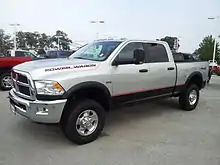 2011 RAM Power Wagon
2011 RAM Power Wagon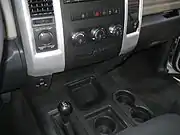 Locker selection control/sway bar disconnect control
Locker selection control/sway bar disconnect control
Powertrain
- 5.7 L Hemi V8 (383 hp / 400 lb ft of torque) for 2010 - 2013 model years
- 6.4 L Hemi V8 (410 hp / 429 lb ft of torque) for 2014 to current model year
Transmission
Beginning in 2010, the Power Wagon is only available with automatic transmissions.
| Model Year | Transmission |
|---|---|
| 2010-2011 | 5-speed 545RFE automatic |
| 2012-2018 | 6-speed 66RFE automatic |
| 2019–present | 8-speed ZF 8HP75-LCV automatic |
Transfer Case
A floor-mounted, manual-shift transfer case was the only option on the Power Wagon, until the 2021 model year when the electronic-shift transfer case was made available as an option.
For 2019 the front driveshaft switched to a CV joint connection at the transfer case.
| Transfer Case | Low Range Ratio | Model Year | Notes |
|---|---|---|---|
| New Venture 271 | 2.72:1 | 2010-2012 | Floor-Mounted Manual Shift On-The Fly. Installed in trucks built up to January 2012. |
| Borg-Warner 44-47 | 2.64:1 | 2012–present | Floor-Mounted Manual Shift On-The Fly. Installed in trucks built January 2012 and later. |
| Borg-Warner 44-46 | 2.64:1 | 2021–present | Electronic Shift On-The-Fly (Optional) |
Axles
Power Wagon models use AAM's "TracRite" locking differentials. The EL model for the front and GTL model in the rear, the differentials are electronically lockable on-demand using controls located on the dashboard, and the rear is limited-slip under normal conditions.
2010 Power Wagon models (along with other Ram trucks) received larger universal joints but retained the AAM 9.25 front and AAM 10.5 rear axle with a 4.56:1 final drive.
For the 2014 model year, with the introduction of the more powerful 6.4L engine, the axle ratio was reduced to 4.10:1. The larger AAM 11.5 rear axle is also introduced for the 2014 model year.
In the 2019 model year changes, the Power Wagon retained the AAM 9.25 front axle, AAM 11.5 rear axle, and 4.10:1 gear ratio; however rear axle internals were changed including different axle shafts, differential carrier, and larger 32-spline pinion.
2014 Update
The 2014 Ram Power Wagon underwent extensive changes. Starting with 2014 models, the Power Wagon comes standard with the new, larger 6.4L Hemi V8. The transmission and transfer case remain unchanged, but the axle ratio changes from 4.56:1 gear ratio to 4:10 gear ratios. The rear axle is exchanged for the larger 11.5 AAM axle.
For 2014 the entire Ram 2500 lineup rear suspension is changed from traditional leaf springs to 5-link coil spring arrangement, and the front suspension has been changed to a radius arm arrangement (3-link) instead of the 5-link previously used. The Power Wagon is equipped with approximately 2" lift over the standard Ram 2500 and is equipped with softer rate springs for off-road performance. Unique to the Power Wagon 3-link front suspension is the "Articulink" front radius arms, which add an extra link and rubber bushing, enabling additional axle articulation. The Power Wagon continues to use Bilstein 4600 shocks. The Power Wagon is equipped with a 5th Bilstein damper, connected to the rear axle to dampen "power hop", a symptom of the 5-link rear suspension during wheel spin.
Factory-equipped tires are changed to Goodyear Wrangler Duratrac but remain 33" (285/70R17).
The 2014 Power Wagon is available in 3 trim levels: Tradesman, SLT, and Laramie. The Power Wagon Laramie trim was eliminated after 2017.
2019 Update
For the 2019 model year, Ram provided a major overhaul of the Heavy Duty lineup. This included a new, fully boxed frame, entirely new front end, and interior updated similar to the DT Ram 1500. However, mechanically the Power Wagon stayed mostly unchanged from the 2018 model year. Notably, it received the ZF 8-speed transmission, over the outgoing Chrysler built 66RFE 6-speed unit. The Power Wagon becomes its own trim level, while "Power Wagon Package" is still available for "Tradesman" trim 2500's, adding the same suspension, axles, wheels/tires, skid plates, and winch as the "Power Wagon" trim version, but in an otherwise more spartan package. For the 2019 model, the winch is updated with a Warn Zeon 12 based unit, with synthetic rope.
75th Anniversary Edition
For the 2021 model year, the Power Wagon is offered with a special "75th Anniversary Edition Package", celebrating the Power Wagon name-plate heritage going back to 1946.[17] The 75AE featured a special "jail bar" vertical bar grille, special badging including an individually numbered plate on dashboard, electronic-shift transfer case, new 17x8.0 beadlock-capable wheels, rock slider steps, special "Mountain Brown" leather bucket seats with center console, and LED projector headlamps borrowed from the top-trim "Limited" models. The 75AE was the first Power Wagon ever available with an electronic shift transfer case, though the option quickly became available on regular Power Wagons. The beadlock capable wheels and rock-slider steps were also later added as available options to regular "Power Wagon" models.
Graphics Packages & Styling
A large part of the Power Wagon name is its bold styling.
The 2010-2013 Power Wagons were available with a red and black graphics package, with large "Power Wagon" lettering on the tailgate and hood.
2014-2016 Power Wagons in SLT trim received a special red grille, and colorful "splash" graphics down the side of the truck with "Power Wagon" spelled out in large lettering on the doors. A large "Power Wagon" decal is also added to the tailgate and blackout hood decal. Blackout projector headlamps are standard. The Laramie Power Wagon receives only a chrome "Power Wagon" emblem on the tailgate.
2017-2018 saw a slightly more subtle graphics package that pays homage to the late 1970s Dodge Macho Power Wagon, with black lower 2-tone paint tying into a vertical black stripe on the bedsides with "Power Wagon" spelled out. It received a slight change to the "Power Wagon" decal on the tailgate and a black-out decal on the top of the hood.
Starting in 2017 Power Wagons get a unique matte-black "handlebar mustache" grille, and black powder-coat front and rear bumpers, blackout emblems, as well as new black 8-spoke wheels. Laramie and Tradesman trim Power Wagons retained chrome bumpers and regular grilles.
2019 graphics package was largely the same as 2018, but with a slight change in font. A "handlebar mustache" grille is retained but redesigned for the new front end. Blackout LED headlamps are standard as well as blackout emblems.
In 2021, the 75AE received special "outline" Power Wagon decals on the front doors and tailgates and did not have the standard hood decal or vertical bed-side decal. It received a new "jail bar" vertical-bar grille, and special "75 Years of Service" emblems on the C pillars. The “jail bar” grille and outline graphics package became optional on 2022 model year trucks.
Gallery
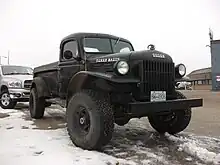 Power Wagon WM-300. This model was sold into the mid-1960s
Power Wagon WM-300. This model was sold into the mid-1960s Red Dodge Power Wagon
Red Dodge Power Wagon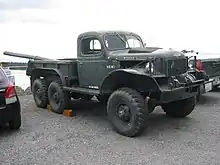 Custom conversion to 6 wheel drive
Custom conversion to 6 wheel drive_USA_(owner_Dan_Hodges).JPG.webp) 1958 WM-300 carryall in US Navy livery
1958 WM-300 carryall in US Navy livery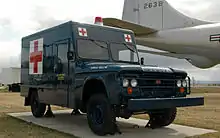 1963 Dodge W200 Power Wagon ambulance, on display at Malmstrom Air Force Base, Montana
1963 Dodge W200 Power Wagon ambulance, on display at Malmstrom Air Force Base, Montana 1965 Dodge Town Wagon Power Wagon W100
1965 Dodge Town Wagon Power Wagon W100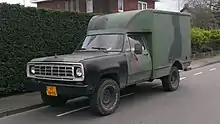 1976 Dodge W200 CUCV
1976 Dodge W200 CUCV Ram 3500 next to Ram 2500 Power Wagon, showing the distinctive grill and winch for the Power Wagon
Ram 3500 next to Ram 2500 Power Wagon, showing the distinctive grill and winch for the Power Wagon
See also
References
- 1 2 3 Press Kit: 2005 Dodge Ram Power Wagon - Legendary Dodge Ram Power Wagon Returns. Chrysler Corporation, DaimlerChrysler AG, Auburn Hills, Michigan, September 30, 2004
- ↑ Brubaker, Ken - Reviews: 2005 Dodge Power Wagon. Four Wheeler Magazine, September 1, 2004
- ↑ Smith, Bruce - First Drive: 2005 Dodge Ram Power Wagon. Hard Working Trucks, April 6, 2010
- ↑ Oldham, Scott - 2020 Ram 2500 Power Wagon Remains a Hulking Heavy-Duty Off-Roader Car and Driver, April 30, 2020
- ↑ Montgomery, Monty. Dodge Power Wagon Photo History. United States: Iconografix, Incorporated, 2000.
- 1 2 Carroll, John. 4 X 4 Vehicles. United States: Chelsea House, 1998.
- ↑ Bunn, Don. Dodge Trucks. United States: Motorbooks International, 1996.
- ↑ About T137 — t137.com
- ↑ The Observer's Fighting Vehicles Directory, World War 2. United Kingdom: F. Warne, 1972.
- 1 2 3 4 5 Ackerson, Robert C.. Standard Catalog of 4 X 4's: A Comprehensive Guide to Four-wheel Drive Vehicles Including Trucks, Vans and Sports Sedans and Sport Utility Vehicles, 1945-1993. United States: Krause Publications, 1993.
- ↑ Petroleum Week. United States: McGraw-Hill Publishing Company, Incorporated, 1958. advertisement: "De Soto and Fargo four-wheel-drive models combine all the features of a conventional two-wheel-drive. Available in Body styles, a chassis-cab, chassis-cowl, or the famous military-type Power-Wagon ( W-300M ) are now available ."
- ↑ The 1947 Dodge WDX Power Wagon That Does Everything – FourWheeler.com
- ↑ 1941 Dodge WC-3 – Estrella WarBirds Museum
- ↑ "The Graham Legacy: Graham-Paige To 1932" by M Keller. – Antique Automobile Club of America (archived)
- ↑ "Notable changes to the Power Wagon 1946 - 1968".
- ↑ "2007 Dodge Ram 2500 Power Wagon - Dodge Diesel Truck - Diesel Power Magazine". www.dieselpowermag.com. Archived from the original on 2011-10-07.
- ↑ Kierstein, Alex - 2021 Ram 2500 Power Wagon 75th Anniversary Edition Celebrates an Icon. Motor Trend, November 10, 2020
External links
- Dodge Power Wagon
- Dodge Power Wagon forums & magazine page
- 1961-71 Dodge Truck Website(Power Wagon)
- Eric's Power Wagon Page
- Power Wagon Registry (2005 and up)
- Power Wagon Forum
- www.T137.com — resource for Dodge Power Wagons including a registry, VIN decoder, serial numbers, forums and archives
- http://www.vintagepowerwagons.com/#!1-ton-flat-fender-dodge-power-wagon/oh69f
- http://www.vintagepowerwagons.com/#!vehicle-identification/kowx1